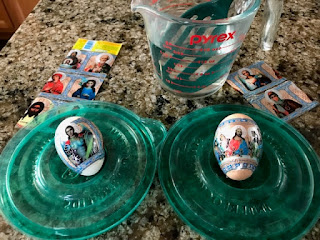My brother and I would crowd around Mom as she supervised the dunking and re-dunking of eggs. My brother was able to put the eggs in the wire dipper and dunk them himself but Mom did the dunking for me. She would dunk as I directed into each color, rotating the eggs so the colors overlapped.
I never associated the colored eggs with anything other than a mysterious milk chocolate bunny in a pretty carton showed up around the same time.
Sometimes we would go to the Museum of Science to watch the baby chicks hatch in their giant display incubator. It was always near the front lobby and was always a first stop whenever we went to that museum.
Other times we would have a picnic in the gardens there. We would find a shady spot and Mom would lay out a blanket on the grass and we would have a grand time eating the surprises she packed for us. When my brother got a bit older, he started playing musical instruments and he would bring a banjo or guitar to the park and we spent the warm spring afternoon singing folks songs. We had no problems singing the same song over and over until we got it "just right".
As I got older sometimes our picnic would be at Griffith Park. There were huge trees and the 3 of us would fan out to sketch them. We each had a sketch book and selection of pencils and off we would go, but not too far, to sketch the trees and limbs. While we were sketching Mom would get the briquette hibachi grill heating up. 1
When the grill was hot, Mom would cook pancakes with warm syrup and scrambled eggs with toast on the grill. Then we would show off our drawings. Full of food we would all take a nap on the blankets she brought and spread out on the grass under the trees.
One of my friends is making colored eggs with her grandchildren. I remarked about all the different styles of colored eggs that mark this part of the year: Easter.
When I lived in Silicon Valley, friend would to bring me one of the special eggs from the Eastern Orthodox Church in San Francisco. She explained that no one really had time to make the intricate designs and so special decorated wrappers were placed around the egg instead.
There are the fabulous Fabergé eggs. 2 50 Imperial Easter Eggs were commissioned for the Tsar and his family of which 43 still exist. Another 15 sets of eggs were commissioned from Fabergé workshop. In all 65 eggs were created and 57 survive.
 |
| The Gatchina Palace Imperial Easter Egg 3 |
 |
| The Gatchina Palace Imperial Egg Opened 3 |
I remember making a papier-mâché Easter egg. It those ancient times, we had Art Class in school. I remember we all got a balloon and the teacher puffed all of them up for us. Then we layered news print strips dredged in a flour and water paste over the balloon. Once the paper wrapper had dried, the teacher popped the balloon, leaving an empty shell that resembled an egg. The remaining weeks were devoted to painting the interior and exterior of the shell. Lastly, we made colored grass by shredding colored paper and placed this inside the painted egg. I don't really remember what it was we put inside but I remember we put something inside on the colored grass and then the teacher sealed the opening with clear cellophane as a window.
Thinking of all the different ways egg shells get decorated, I checked in at my favorite deli and asked if they had the "decals" for the eggs. They explained they don't use decals but have pre-printed sleeves with various images that you separate and put over the egg. Then you immerse the egg in hot water. Modern meets Ancient.
 |
| Shrink Wrapped Easter Eggs4 |
References
- The traditional Japanese hibachi is a heating device and not usually used for cooking. In English, however, "hibachi" often refers to small cooking grills typically made of aluminum or cast iron, with the latter generally being of a higher quality. Owing to their small size, hibachi grills are popular as a form of portable barbecue. They resemble traditional, Japanese, charcoal-heated cooking utensils called shichirin.
https://en.wikipedia.org/wiki/Hibachi
https://en.wikipedia.org/wiki/Shichirin
https://en.wikipedia.org/wiki/Brazier
https://en.wikipedia.org/wiki/Briquette
- The House of Fabergé made 65 easter eggs. 50 of these were Imperial Eggs created for the Russian Tsars Alexander III and Nicholas II. Virtually all were manufactured under the supervision of Peter Carl Fabergé between 1885 and 1917.
https://en.wikipedia.org/wiki/Fabergé egg
- The Gatchina Palace egg is a jewelled, enameled Easter egg made under the supervision of the Russian jeweler Peter Carl Fabergé in 1901, for Nicholas II of Russia. Nicholas II presented it to his mother, the Dowager Empress Maria Feodorovna, at Easter in 1901. The egg opens to reveal a surprise miniature gold replica of the palace at Gatchina.
https://en.wikipedia.org/wiki/Gatchina Palace (Fabergé egg)
- Cut out one of the selections from the Easter Egg Decoration Sleeve. Slip this over the hard boiled egg. Dip in very hot water. The plastic sleeve will shrink wrap about the egg in a few seconds.

No comments:
Post a Comment